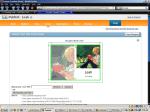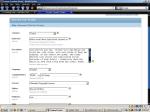Well, today is the day. At long last I get the publishing process for Leah rolling. Here’s a review of the steps I took (with screenshots!).
1. Sign In
I already have a Lulu account, of course, so I logged in and started a new project. I clicked the “Publish” tab, then clicked “Paperback books”, and then “Get Started”.
2. Start Tab
Here, I simply provided the title and author’s name. I also selected the “Make It Public” option because I want to be able to offer the book to readers later on. Clicked Save & Continue.

(Click For Larger Image)
3. Options Tab
Next, I had to determine what kind of format I wanted my book to take. I chose the usual options for a novel: Standard paper (not Publisher Grade); book size: US Trade; perfect binding; and black & white color.

Choose the Physical Properties of Your Book
4. Files Tab
Now we upload, and this is where the preparations that I described in my earlier posts (here and here) paid off. I upload two of the three PDF documents that I had prepared: the manuscript and the title/copyright page. Once they’re uploaded, I arranged the files in the right order (the title page document goes first), and then Lulu automatically merged the two documents together and allowed me the chance to review that merged file.

Upload Files
5. Cover Tab
The next step takes care of the other PDF file that I had prepared: the one with the cover of the book. If you haven’t designed a cover or don’t care about the cover design (although you should) this is the stage where Lulu can assist in creating a generic cover. I’ve designed my own cover, though, so I clicked on the “Upload One-Piece Cover” button and uploaded my document.

Pay No Attention To That Green Fringe
A year ago, when I was publishing The Spring, this screen confused me. I knew that I was supposed to create a “bleed” zone around my cover, which I did. But the weird green border that you see in the image above confused me and made me second guess what I had done. I actually went back and tinkered with the size of the cover, which proved to be a mistake when my proof copy arrived and I saw that I had made the border around the cover image too large. This time, I played it cool and just clicked “Save & Continue”. If there is a problem when I get the proof copy, then I’ll make adjustments later, but I think the cover is going to turn out fine.
6. Description Tab
Here, I filled in the basic info for the content of the book. All of the fields were filled in except for the ISBN number because at this stage in the process, I hadn’t been assigned a number yet. As you can see, I placed the novel in the “Teens” category as opposed to the “Fiction & Literature” category (I would have preferred to place it in both). I’m not sure if that was the right thing to do, but I can change it later if I need to.

Everything But the ISBN
7. Price Tab
I hope you like to wrestle, because this is one of those screens which will resist everything you try to do. You can see in the screenshot that there are two open fields in the “Retail Print” section. Don’t try to enter anything in the “Price” field — only tinker with the “My Revenue” field and let the values that you insert there adjust the “Price” field for you.

Just Adjust the My Revenue Box
I wanted to make sure that I set the price for Leah to be less than the price I set for The Spring, just because Leah is a bit shorter than The Spring. You can see in the screenshot that the author’s cut of the money, especially when selling through retailers like Amazon, is very small. (This is where Lulu authors get greedy and why some 200-page novels published through Lulu cost upwards of $30.) Whether publishing the old-fashioned way or through POD, the sad fact is that authors just don’t earn much from each individual sale. It’s a good thing that creative writing isn’t my day job!
And I will, of course, make the novel available as a free download.
8. Review and Order
After that, I am asked to review everything, make sure it’s OK, and then I order a proof copy. I do have to pay for a proof copy, but since I’m the author of the project, I don’t have to pay the full price that I set for the novel back in the Price Tab. Instead, I only pay for the for the cost of manufacturing a copy and shipping it to me. I added my book to my virtual shopping cart, but I didn’t check out just yet because I still have one more thing to do.
9. “Purchase” a Distribution Package
“Purchase” is in quotation marks because I didn’t actually have to purchase anything here. If you publish your novel through Lulu (as opposed to choosing the “Published by You” option) you don’t have to pay anything. This is apparently a new development for Lulu because I remember a year ago, when I published The Spring, I did have to pay about $100 for the distribution package.
The most important part of the package is the assignment of an ISBN number. You need this if you want to sell your book either online or in a bookstore. If I could change one thing about Lulu’s publishing process it would be that I would like to get my ISBN number before I uploaded the PDF files for the Title/Copyright document and the book cover so that the proof copy that I ordered would be sent to me complete. Instead, I’ll have to add the ISBN number to the copyright page and insert the ISBN bar code to my cover after I’ve reviewed the proof copy. Perhaps Lulu wants to make sure that authors take that step of reviewing the proof copy before approving the book for publication and making it available to everyone.
The whole process took about 90 minutes to complete. That’s perhaps longer than usual since I was taking screenshots of my progress and writing notes in WordPress.
So now I wait for the proof copy of my book to be manufactured and sent to me. That, unfortunately, will probably take at least a week.
Questions? Comments?







